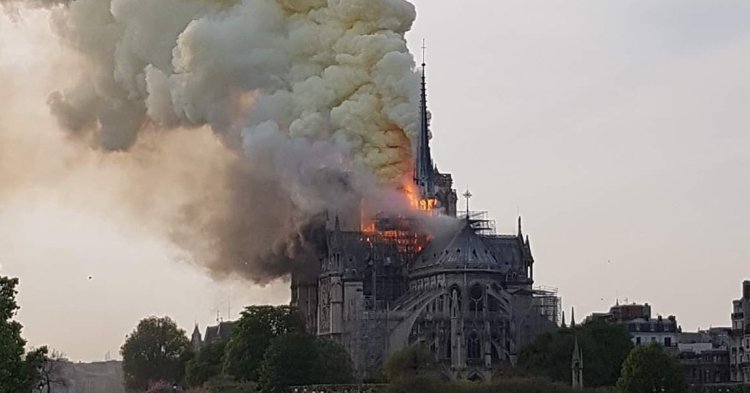Juuso Järviniemi, The New Federalist: Different languages, shared emotion
As I was writing this text late yesterday night, I still heard the sirens of police cars on the street underneath my window. I was at school as Notre-Dame caught fire, and heard about the incident from my Canadian friend who texted me from Scotland. On my way home, as I joined the crowd watching the iconic cathedral burn, I sent a message to my mother in Finland. She had heard the news before I did. The whole Europe, and the wider world, is speaking about the fire, because the world cares.
At 9:45pm, hundreds of people had gathered at Place Saint-Michel near the cathedral. Tourists joined in the solemn mood as many locals wept in disbelief. Citizens sang religious songs together in the warm spring night. In the crowd, you could hear not only French, but also German, British English and other languages. The language was different, the emotion was shared. In his speech later, French President Emmanuel Macron underlined how the cathedral is at the heart of French history. The emotion expressed by Europeans far and wide demonstrates that Notre-Dame is not only a part of French heritage – it is also a part of our shared European imaginary.
Gesine Weber, Treffpunkt Europa: May it never fall
Notre Dame is 865 years of history. Its walls have seen so many conflicts, so many floods, the French Revolution, two World Wars. In its majesty, as a compass in the heart of Paris, it has inspired endless drawings, literature, poetry, and so many dreams. The fire of Notre Dame strikes right in the heart of French, European and global heritage. Notre Dame is not only a cathedral: it’s the incarnation of the history of Paris, France and Europe, of the creative capacity of humankind, of architectural perfection leaving its visitors speechless, and that is why this fire is so tragic, so painful, and so incredibly sad.
Nevertheless, this history is not over. The foundation walls and the two main towers did not fall, and they will continue to represent firmness of this monument and stand the test of time. In this situation, it seems that the city of Paris has wisely chosen its motto “fluctuat, nec mergitur” - “she is rocked by the waves, but does not sink”. In the Armoiries de la Ville de Paris, this motto is explained in detail: “Like the ship which, beaten by the storm, gets up stronger again, and benefits from the furious winds to arrive faster at the port, the destination of its long and perilous journey, this ancient and noble city has not only surpassed the damage; she has taken from it the conviction that, if new challenges are reserved for her, she is always come out of it victorious.”
Those who made Notre Dame come out of the fire, damaged but victorious, were hundreds of firefighters, and now, it is up to us to preserve the memory of what is lost and to resurrect the history and the memories inside this cathedral when its being rebuilt. Notre Dame might have been flames, but it will never fall.
Louise Guillot & Laura Mercier, Le Taurillon: Notre Dame engulfed in flames, but its soul is eternal
Yesterday night, at around 7 pm, the cathedral of Notre-Dame de Paris suffered a terrible fire which ravaged a large part of its structure. Its frame, dating back to the 13th century, was consumed, its arrow culminating at 93 metres since 1860 collapsed, and with it, Paris as a whole. More than 400 firemen came together to try to overcome this gigantic inferno and save whatever could be saved.
Being one of the most visited monuments in Europe and listed as World Heritage Site by UNESCO, Notre-Dame de Paris is not only a Christian symbol. It was, for example, vandalised and renamed “Temple of Reasons” during the French Revolution, and this is where the Liberation of Paris was celebrated after the Second World War.
Social networks were flooded with instantly published photos, live videos, #NotreDame hashtag, reactions in France, reactions in Europe, and beyond. The shock, the incomprehension, and humility. The search for a shelter, in Victor Hugo’s words, in drawings of the Hunchback of Notre-Dame, in everyone’s memories of this monument, of this Lady. Memories of a Parisian wander, of a family visit, of a detour through the Île de la Cité. Yesterday, around 19:30, in the space of a few minutes, we were all faced with powerlessness, devastated to see the heart of Paris being prey to the flames.
Yesterday night, messages of solidarity and support for France, for Paris and Notre-Dame were shared in dozens of languages across the European continent and beyond.
This morning, the newspapers’ front pages illustrated the consternation and immense sadness shared by millions of citizens. This morning too, we were looking for right and thoughtful words to relate this event which leaves us voiceless.
Finally, we leave you with these few sentences of Victor Hugo, who depicted so well this grandiose cathedral:
“All eyes were raised to the top of the church. They beheld there an extraordinary sight. On the crest of the highest gallery, higher than the central rose window, there was a great flame rising between the two towers with whirlwinds of sparks, a vast, disordered, and furious flame, a tongue of which was borne into the smoke by the wind, from time to time. Below that fire, below the gloomy balustrade with its trefoils showing darkly against its glare, two spouts with monster throats were vomiting forth unceasingly that burning rain, whose silvery stream stood out against the shadows of the lower façade. As they approached the earth, these two jets of liquid lead spread out in sheaves, like water springing from the thousand holes of a watering-pot. Above the flame, the enormous towers, two sides of each of which were visible in sharp outline, the one wholly black, the other wholly red, seemed still more vast with all the immensity of the shadow which they cast even to the sky. Their innumerable sculptures of demons and dragons assumed a lugubrious aspect. The restless light of the flame made them move to the eye. There were griffins which had the air of laughing, gargoyles which one fancied one heard yelping, salamanders which puffed at the fire, tarasques which sneezed in the smoke. And among the monsters thus roused from their sleep of stone by this flame, by this noise, there was one who walked about, and who was seen, from time to time, to pass across the glowing face of the pile, like a bat in front of a candle. Without doubt, this strange beacon light would awaken far away, the woodcutter of the hills of Bicêtre, terrified to behold the gigantic shadow of the towers of Notre-Dame quivering over his heaths.” [1]
Today, Notre Dame remains grandiose and will continue to endure through the centuries of History.
Lorène Weber, The New Federalist: Sonnet for Notre-Dame
Paris grieving tonight, its Lady has vanished
The city’s soul and flesh were sorely wounded
And Parisians witnessed, powerless as I am
The flames, relentlessly, devouring Notre-Dame
Yet they shook themselves up, once the first blow had passed
Desperate but valiant, they tirelessly tried
To save their precious Saint, their Mary and their pride
But despite all their toil, the arrow fell and cracked
Now time has come to pray, to commune and to cry
As Palm Sunday’s branches disappear in the sky
For Passion and Easter, we will all be orphans
And yet resurrection will heal and come to light
The city today mourns, but will soon glorify
Rising from its ashes, Notre-Dame’s revival






Follow the comments: |
|
